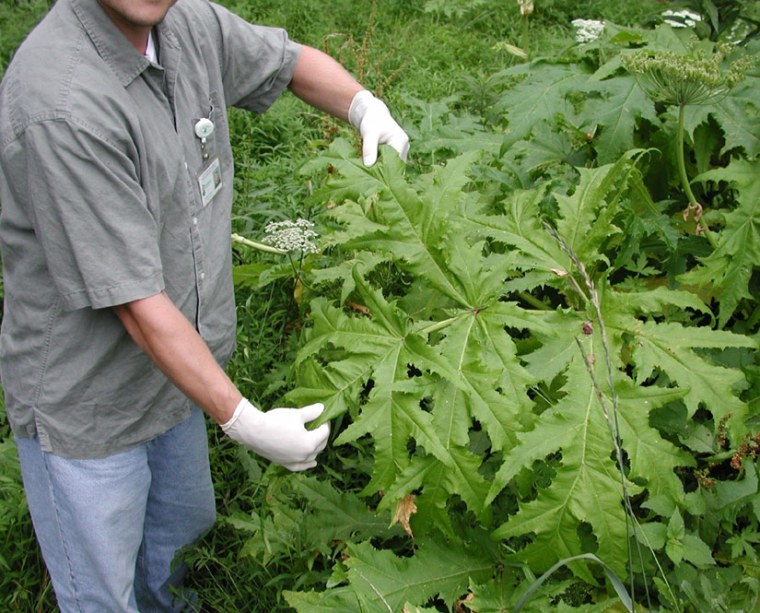It's exotic and beautiful, a 15-foot-tall plant with clusters of dainty white flowers and human-sized leaves — resembling, it is often said, Queen Anne's Lace on steroids.
But giant hogweed is an invasive species that is spreading around much of the northern United States. Even worse, its sap is extremely poisonous, with the potential to cause blistering burns and even blindness.
Now that the giant hogweed's flowering season is here again, experts are taking the opportunity to draw people's attention to the plant — for the sake of human health as well as for the health of the environment.
"It's one of the few invasive species that has such a severe human health impact, and people should really know about it," said Chuck O'Neill, coordinator of the Cornell Cooperative Extension Invasive Species Program in Ithaca, NY. "Unfortunately, I'd say 80 or 90 percent of people hiking have no idea what these plants look like."
"Like the zebra mussel, they can be a poster child for invasive species," he added. "There's a certain appeal to a plant that's this big with that cringe factor of what it can do to you that gives you an opening to start talking about a lot more plants, animals and insects that are invasive."
The giant hogweed's story of invasion began in 1892, when two European brothers went on a botanical expedition to the Caucuses region of Eurasia, where they saw the plant for the first time, said botanist Naja Kraus, manager of the New York State Department of Environmental Conservation's Giant Hogweed Program. Wowed by its height and beauty, they brought its seeds back to Europe, along with a variety of other species.
Enamored botanists quickly spread giant hogweed from garden to garden around Europe. It arrived in the United States in the early 1900s. It's not clear if botanists knew about the plant's poison — and whether they cared.
Even today, people choose to put giant hogweed in their gardens, but the plant carries real risks. Toxic sap lies inside its bamboo-like hollow stalks. If the sap gets on your skin, the exposed area becomes unable to protect itself from the sun's rays, leading to terrible blistering burns, followed by skin discoloration and darkening that can persist for years.
Wild parsnip and cow parsnip cause similar reactions, but giant hogweed's effects are far more severe. If the sap gets in your eyes and is then exposed to sunlight, it can cause blindness.
Sap can ooze out onto the leaves and stem, making the plant dangerous just to brush up against. And it doesn't produce flowers until it has been growing for a few years, which means that it isn't always easy to identify.
But people aren't the only victims of giant hogweed. The environment is at risk, too. Giant hogweed starts growing in April, before many native species have started to poke through. It grows rapidly. And a single plant can produce as many as 100,000 seeds in late summer.
Most seeds fall just a few meters from the parent plant, so the weed's spread is more creeping than explosive. But its shady nature and fast growth help it smother and replace other kinds of plants.
So far, giant hogweed has been found growing in New York, Connecticut, Massachusetts, Washington, D.C., Pennsylvania, Ohio, Maryland, Virginia, Vermont, New Hampshire, Maine, Michigan, Illinois, Wisconsin, Oregon, Alaska and Washington state, as well as in parts of Canada, such as British Columbia and Ontario, and throughout Europe — and possibly other places.
The good news, Kraus said, is that giant hogweed is controllable, and many states are making major efforts to eradicate it. In New York, her crews regularly visit about 1,000 sites, ranging from private property to state roadsides. Workers wear waterproof clothing from head to toe, and they learn how to get out of their suits to avoid touching the sap.
"I think this probably feels like a crisis to people who are just hearing about it because it's a very frightening plant, but I don't think it's any more of a crisis than it was 10 years ago," Kraus said. "It's spreading in some areas where we don't know about it, but it's decreasing in other areas where we do know about it and are controlling it."
To protect yourself, she recommended first learning what giant hogweed looks like. If you see it, don't touch it. If you touch it, quickly wash your hands with soap and water. Then, call your state's department of natural resources or conservation and report it. The same goes for other invasive and poisonous species, O'Neill added.
Like poison ivy, Kraus said, giant hogweed is just another plant you should know about before spending a lot of time outdoors.
"You want to know what's dangerous," she said. "You should just add these plants to your list of plants to stay away from.
